What diazepam looks like
Rectal diazepam, also known as Stesolid®, comes in a prefilled yellow rectal tube. The tube has a nozzle on the end. One tube has 5mg of diazepam in 2.5mL of liquid. You give it rectally into the bottom.
The prescription the doctor gives you will tell you how much diazepam to give. You will also find this information in the seizure plan and on the medicine packet.
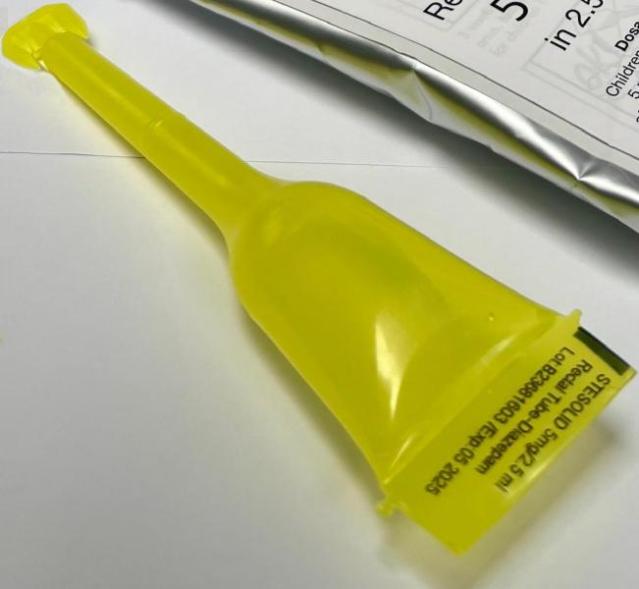
A photo of a tube of diazepam.
Source: KidsHealth
How to store diazepam
Store the diazepam at room temperature. Don’t leave the diazepam in a hot place like your car or bathroom. Keep it away from light. You must keep the diazepam in the foil packaging.
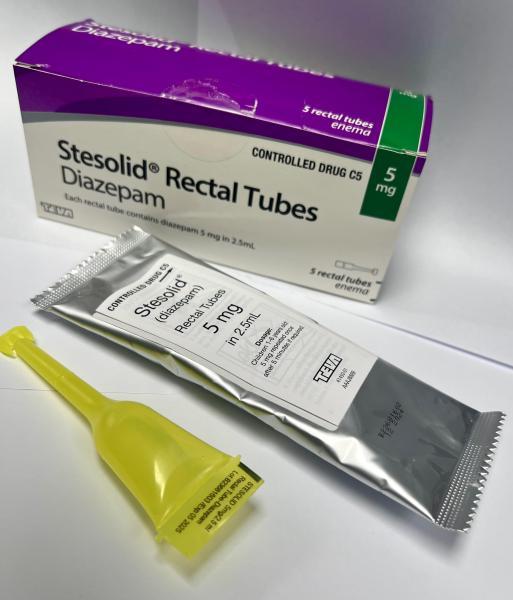
A photo of a Stesolid® tube, foil packet and box.
Source: KidsHealth
transcribeTranscript
The photo shows three items:
- A purple and white box labelled:
- 'Stesolid® Rectal Tubes – Diazepam'
- 'Controlled Drug C5'
- '5 mg'
- 'Each rectal tube contains diazepam 5 mg in 2.5 mL'
- Box indicates it contains 5 rectal tubes (enemas)
- A silver foil packet with a white label reading:
- 'Stesolid® Rectal Tubes – 5 mg in 2.5 mLs
- 'TEVA' (manufacturer)
- A yellow plastic rectal tube placed in front, ready to use.
This is a form of emergency medicine used to stop seizures.
Diazepam expiry date
There is an expiry date on the box. Regularly check the diazepam hasn’t expired. Return any expired diazepam to your pharmacy.
If you need an ongoing supply, you can get this from your health professional.
How to prepare the diazepam
This video shows how to prepare diazepam (Stesolid®) before giving it to your child.
This video has no audio.
Source: KidsHealth
Steps on how to prepare the diazepam
Follow these steps if your child’s seizure is still actively going at 4 minutes.
Get your diazepam - Stesolid® tube.
Open the foil pack of a Stesolid® tube.
Remove the cap of the Stesolid® tube by turning it 2 or 3 times without pulling.
Check the dose your child needs. If your child needs 2.5mg, push out half of the liquid from the 5mg tube.
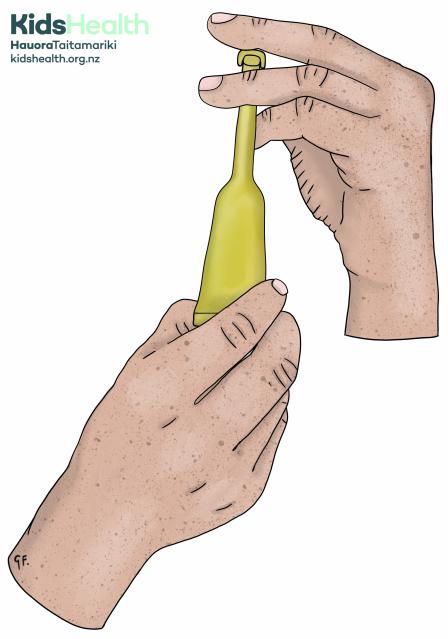
An illustration showing how to hold the Stesolid® tube.
Source: KidsHealth
Instructions for giving rectal diazepam
Put your child in the recovery position.
Hold one buttock gently to one side so that you can see the entry to their bottom (anus).
Gently insert the nozzle of the Stesolid® tube into your child’s bottom. Point the tube slightly downwards.
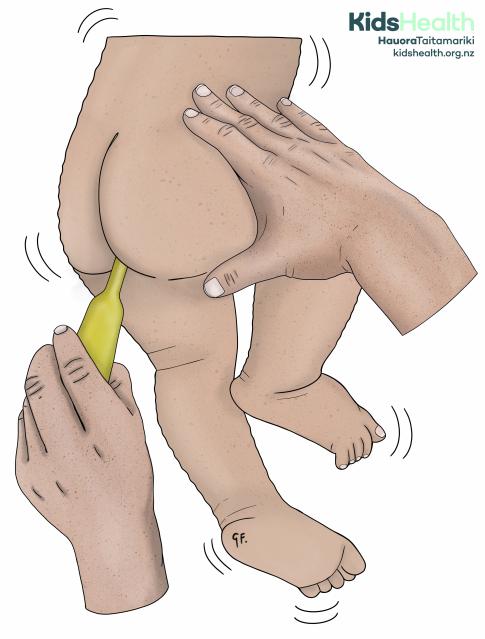
An illustration showing how to give Stesolid® into a child's bottom.
Source: KidsHealth
For pēpi (babies) and tamariki under 3 years old - insert the nozzle halfway. For tamariki aged 3 years and older, insert the whole nozzle. Stesolid® tubes have marks on the nozzle to guide you.
Give the diazepam. Do this by firmly squeezing the Stesolid® tube between your index finger and thumb.
Keep the Stesolid® tube squeezed while you remove the nozzle from your child’s bottom.
Hold your child’s buttocks together for about a minute to make sure the diazepam doesn’t leak out. There may be a small amount of liquid left in the Stesolid® tube, but this doesn’t matter.
See an emergency plan with steps on what to do if your child has a seizure and how to give rectal diazepam.
Print the emergency plan and keep it with the diazepam. Refer to this plan when your child has a seizure.
What to do after giving your child diazepam
After you have given diazepam
- watch your child’s breathing
- continue to time the seizure
Dial 111 within New Zealand and ask for urgent medical help if:
- the seizure does not stop within 1 minute of giving the diazepam
- you are worried about your child’s breathing
If your doctor has given you specific instructions on when to call 111, follow their advice.
Printable emergency seizure plan
An emergency seizure plan is a step-by-step guide for what to do if your child is having a seizure. It includes steps to take for giving rectal diazepam.
The emergency seizure plan is available as a flow chart or as text instructions.
Print out a plan and keep a copy with your supply of medicine.
Follow the links to see all available formats. You can get the emergency seizure plans as a flow chart or as written instructions.
Preview
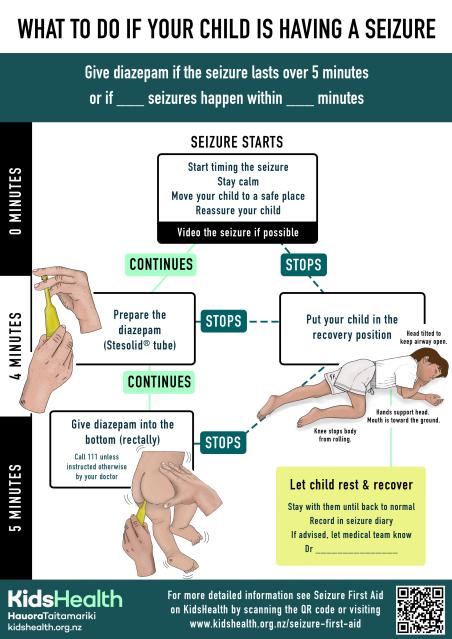
An illustrated emergency seizure plan. It explains what to do if your child is having a seizure. It shows when to give emergency seizure medicine (diazepam), how to give it, and how to help your child recover safely.
Source: KidsHealth
transcribeTranscript
The illustration is a step-by-step seizure action plan with images and text arranged in a flow chart format. A black vertical bar on the left marks the time from 0 minutes to 5 minutes.
At the top, the title says:
'WHAT TO DO IF YOUR CHILD IS HAVING A SEIZURE'
A green box below adds:
'Give diazepam if the seizure lasts over 5 minutes or if ___ seizures happen within ___ minutes'.
At 0 MINUTES – Seizure starts:
- A black box lists actions:
- Start timing the seizure
- Stay calm
- Move your child to a safe place
- Reassure your child
- Video the seizure if possible
If the seizure CONTINUES:
- An image shows a hand holding a Stesolid® tube.
- Text: Prepare the diazepam (Stesolid® tube)
If the seizure STOPS at any point:
- A child is placed in the recovery position with labels pointing to:
- Head tilted to keep airway open
- Hands support head, mouth toward the ground
- Knee stops body from rolling
At 5 MINUTES if seizure continues:
- An image shows rectal administration of the medicine.
- Text: Give diazepam into the bottom (rectally)
- Green text adds: Call 111 unless instructed otherwise by your doctor
If the seizure STOPS after diazepam:
- Green box: Let child rest & recover
- Stay with them until back to normal
- Record in seizure diary
- If advised, let medical team know
- Line to write doctor’s name: Dr ____________
Bottom of the illustration:
- A green banner with a QR code reads:
'For more detailed information see Seizure First Aid on KidsHealth by scanning the QR code or visiting www.kidshealth.org.nz/seizure-first-aid'
At the bottom right is the KidsHealth logo with the website: kidshealth.org.nz.
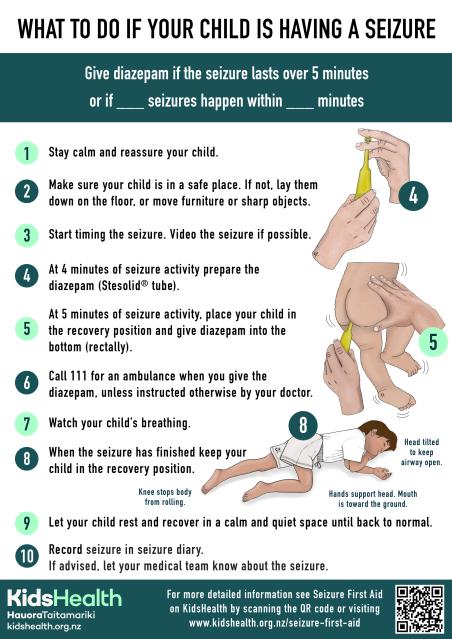
An illustrated emergency seizure plan. It explains what to do if your child has a seizure. It provides instructions for giving emergency seizure medicine (diazepam) and helping your child stay safe and recover.
Source: KidsHealth
transcribeTranscript
The illustration is a step-by-step numbered list showing what to do if your child has a seizure. There are ten numbered steps, some with small illustrations alongside.
At the top, the title reads:
'WHAT TO DO IF YOUR CHILD IS HAVING A SEIZURE'
Underneath is a green banner with the instruction:
'Give diazepam if the seizure lasts over 5 minutes or if ___ seizures happen within ___ minutes'.
The steps are:
- Stay calm and reassure your child.
- Make sure your child is in a safe place.
If not, lay them down on the floor, or move furniture or sharp objects. - Start timing the seizure.
Video the seizure if possible. - At 4 minutes of seizure activity prepare the diazepam (Stesolid® tube).
(Illustration of 2 hands holding the Stesolid® tube is shown.) - At 5 minutes of seizure activity, place your child in the recovery position and give diazepam into the bottom (rectally).
(An illustration shows how to give rectal Stesolid®.) - Call 111 for an ambulance when you give the diazepam, unless instructed otherwise by your doctor.
- Watch your child’s breathing.
- When the seizure has finished keep your child in the recovery position.
(Illustration of the child in recovery position with labels:- 'Head tilted to keep airway open'.
- 'Mouth is toward the ground'.
- 'Hands support head'.
- 'Knee stops body from rolling'.)
- Let your child rest and recover in a calm and quiet space until back to normal.
- Record seizure in seizure diary.
If advised, let your medical team know about the seizure.
At the bottom of the illustration is a green box with a QR code and text:
'For more detailed information, see Seizure First Aid on KidsHealth by scanning the QR code or visiting www.kidshealth.org.nz/seizure-first-aid'
At the bottom right is the KidsHealth logo with the website: kidshealth.org.nz.
Acknowledgements
Illustrations by Dr Greta File. Property of KidsHealth.
The content on this page has been developed and approved by the Paediatric Neurology Clinical Network, Paediatric Society New Zealand.
